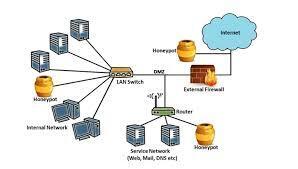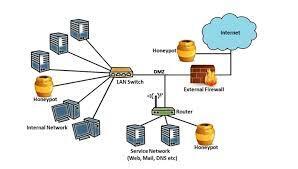Honeypots in Cybersecurity
In the ever-evolving battlefield of cybersecurity, honeypots act like digital bait—traps that lure cyber attackers into a controlled environment where their behavior can be studied without compromising real systems.
What is a Honeypot?
A honeypot is a decoy system or network designed to appear vulnerable and attractive to hackers. Its main goal? Detect, deflect, or analyze attacks before they reach actual systems.
Think of it like a fake vault in a bank. It looks valuable and accessible but is being watched from every angle, waiting for the thief to make a move.

** Why Use Honeypots?**
Early Threat Detection
- Honeypots can identify zero-day exploits and attack patterns before they’re known.
Learning Attacker Tactics
- They allow security teams to observe attackers in action without exposing critical infrastructure.
Reducing False Positives
- Unlike firewalls or intrusion detection systems, honeypots have no legitimate traffic, so any interaction is considered malicious.
Types of Honeypots
Low-Interaction Honeypots
Simulate basic services (e.g., open ports). They're safe and easy to deploy but offer limited intelligence.
- Example: A fake login page that logs attempts without allowing real access.
Medium-Interaction Honeypots
Emulate more of the system's behavior—enough to engage attackers longer and gather more data.
- Example: A simulated SSH server that responds with realistic prompts but doesn’t give actual shell access.
High-Interaction Honeypots
Fully functional environments where attackers believe they’ve broken in. They provide deep insights but come with higher risk and complexity.
- Example: A full virtual machine running outdated software with logging and monitoring tools embedded.

Honeypots vs. Honeynets
A honeynet is a network of honeypots—more complex, but offers richer data.
Honeynets can simulate entire organizations, letting attackers explore and reveal more of their methods.
Real-World Use Cases
Military & Government: Track nation-state hackers.
Enterprises: Identify insider threats or vulnerabilities.
Research Institutions: Study malware and botnet behaviors.
Conclusion
Honeypots are not replacements for traditional security measures like firewalls or antivirus software. Instead, they’re strategic tools to gain intelligence, improve defenses, and understand the enemy.
If you’re in cybersecurity or just getting into it, honeypots are an exciting, proactive way to fight back.
sources
https://medium.com/@rahulsharan512/honeynets-and-honeypots-a-simple-way-to-boost-network-security-5011490674d2
https://www.sciencedirect.com/topics/computer-science/low-interaction-honeypot
https://us.norton.com/blog/iot/what-is-a-honeypot
https://www.imperva.com/learn/application-security/honeypot-honeynet/
https://spyscape.com/article/risky-business-using-honeypots-to-lure-hackers

